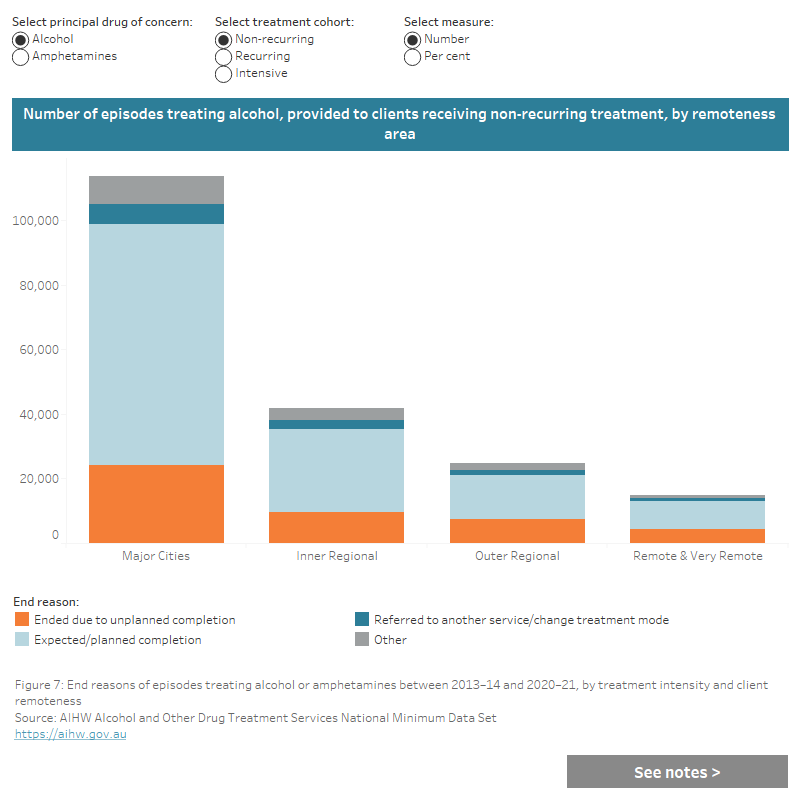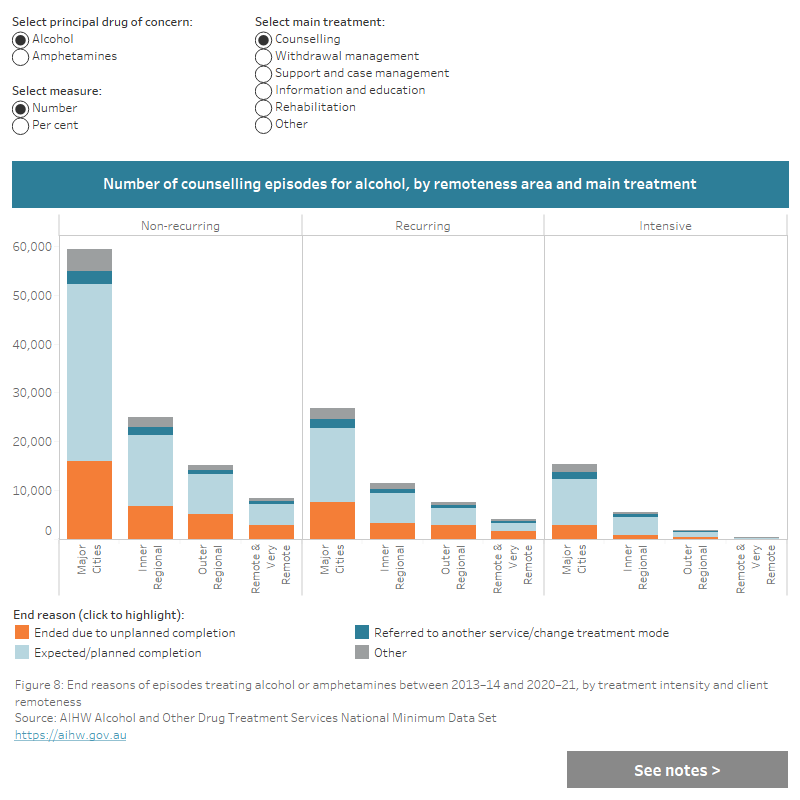Client remoteness
Geographic location is a prominent factor in treatment accessibility, particularly for clients living or seeking treatment in Remote & very remote areas of Australia (AIHW 2019).
Across all treatment episodes provided in the study period, the proportions broadly follow the population distribution with the majority (61% of episodes for alcohol; 68% of episodes for amphetamines) provided to clients living in Major cities, followed by those in:
- Inner regional areas (21% or 77,141 episodes for alcohol; 21% or 52,939 episodes for amphetamines)
- Outer regional areas (12% or 42,338 episodes for alcohol; 9.1% or 22,933 episodes for amphetamines)
- Remote & very remote areas (6.5% or 23,818 episodes for alcohol; 1.8% or 4,621 episodes for amphetamines).
Clients who received intensive treatment were more likely to live in Major cities (71% episodes for alcohol; 75% for amphetamines) than those who received non-recurring (58% for alcohol; 67% for amphetamines) or recurring treatment (59% alcohol; 66% amphetamines) (Figure 7).
Across all treatment cohorts for both alcohol and amphetamines, the likelihood of unplanned completion increased with remoteness. This may be due to a range of factors, including accessibility to treatment services and travel time (AIHW 2019).
These trends varied by treatment type and principal drug of concern, as shown in Figure 8.
Figure 7: End reasons of episodes treating alcohol or amphetamines between 2013–14 and 2020–21, by treatment intensity cohort and client remoteness
This interactive data visualisation shows the number and proportion of episodes provided to clients receiving intensive, recurring and non-recurring treatment for alcohol or amphetamines. Episodes are presented by reason for cessation and remoteness area.

Figure 8: End reasons of episodes treating alcohol or amphetamines between 2013–14 and 2020–21, by treatment intensity cohort, client remoteness and main treatment type
This interactive data visualisation shows the number and proportion of episodes provided to clients receiving intensive, recurring and non-recurring treatment for alcohol or amphetamines. Episodes are presented by reason for cessation, remoteness area and main treatment.

Alcohol
Among treatment episodes for alcohol:
-
Rehabilitation episodes had similar likelihood of unplanned completion across most cohorts and remoteness areas (35–38%), with the exception of non-recurring clients in Inner regional areas (42%) and Remote & very remote areas (31%).
- Among other treatment types, episodes provided in Outer regional and Remote & very remote areas had a higher likelihood of unplanned completion than episodes provided in Major cities and Inner regional areas across all three treatment cohorts.
- Counselling provided to clients in Remote & very remote areas had a lower likelihood of planned completion where clients received intensive treatment, compared to those who received non-recurring and recurring treatment:
-
31% of counselling episodes provided to clients receiving intensive treatment for alcohol ended as planned
-
43% and 52% of episodes provided to clients receiving recurring and non-recurring treatment ended as planned.
-
Amphetamines
Among treatment episodes for amphetamines:
- Rehabilitation episodes had similar likelihood of unplanned completion across most cohorts and remoteness areas (40–50%), with the exception of the relatively small number of episodes provided to clients living in Remote & very remote areas.
- Among other treatment types, episodes provided in Outer regional and Remote & very remote areas had a higher likelihood of unplanned completion than episodes provided in Major cities and Inner regional areas across all three treatment cohorts.
For further detail, refer to Supplementary tables BLTN.11 and BLTN.12.
AIHW (2019). “Alcohol and other drug use in regional and remote Australia: consumption, harms and access to treatment, 2016–17.” Cat. no. HSE 212. Canberra: AIHW.


